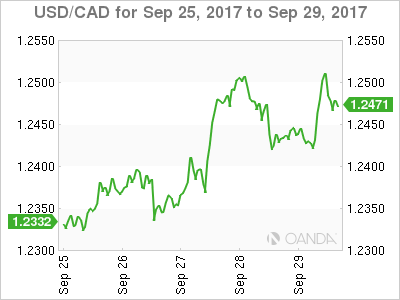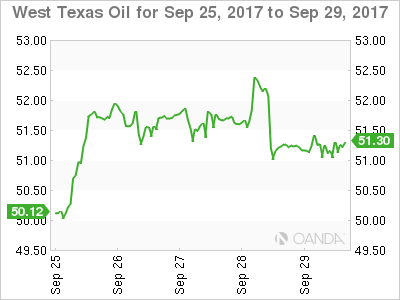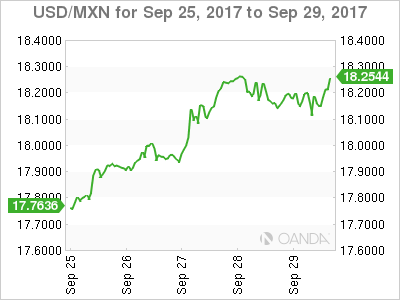The Canadian dollar finished the week lower versus its US counterpart after the gross domestic product in Canada was flat in July. The economy had registered 8 consecutive months of strong growth that prompted the Bank of Canada (BoC) to raise interest rates twice in the last three months. Dovish comments form the central bank governor Stephen Poloz earlier in the week and the slowdown in the momentum of the economy raise serious questions about another rate hike this year.
Oil offered little support for the currency despite prices rising during the week after concerns with a potential disruption in Northern Iraq. The referendum vote in the Kurdish region has not been recognized by the central Iraqi government. Allies of Iraq have pledged to cut off the region from selling its natural resources. US energy production has recovered from the effects of hurricanes Harvey and Irma and has balanced the potential losses in supply in the short term.
Gold is trading lower on Friday as geopolitical risks have dampened, but with the ongoing situation with North Korea as well as the upcoming Catalunya referendum in the horizon the yellow metal could catch a bid.
Next week’s economic calendar is packed with the highlights for CAD traders being the US crude oil inventories and a speech by Fed Chair Janet Yellen on Wednesday, Canadian trade balance numbers on Thursday and Canadian and US jobs numbers on Friday.

The USD/CAD gained 1.098 in the last week. The currency pair is trading at 1.2469 in a week that featured NAFTA negotiations, central bank speakers and US tax reform in the agenda. The pair touched weekly highs of 1.2533 on Thursday only for the CAD to regain some ground but still finish lower versus the USD in a weekly basis.
Governor Stephen Poloz said on Wednesday there is no predetermined path for theinterest rate and that the central bank would proceed with caution. The rhetoric was less hawkish than that seen in the summer. Unknowns are making estimating the appropriate rate path hard, but then again that has been the situation in all of 2017. The loonie has been one of the best performers this year after the two rate hikes, but has lost momentum after the Fed has signalled a third rate hike of the Fed funds rate while Poloz seems to be pumping the breaks. The comments from the BoC indicate a slower rate path that could see the central bank standing pat for the remainder of the year.
Canadian employment data will be released on Friday at 8:30 am EDT. Canadian employment has impressed with steady gains in the number of jobs. The 22,000 new jobs added last month were for the most part part-time positions. The economy is consistently losing full time positions and with the worries of the central bank about high household debt the CAD could be under pressure for the remainder of 2017.

Energy prices gained 2.018 in the last week. West Texas Intermediate is trading at 51.21 as the threat of supply disruption in Northern Iraq has increased the price of crude. Global demand has been forecasted to be higher, but so supply continues to create a glut. US oil production rose 9 percent during the last three weeks offsetting reports of stronger forecasted demand and a possible Organization of the Petroleum Exporting Countries (OPEC) cut agreement extension. Saudi Arabia used overproduction as a strategy to grab market share and drive prices lower with the intent to drive the US shale industry into bankruptcy. The strategy backfired as the flexibility of US drillers and low rates made it easier to service the debt and wait for the OPEC to reach an agreement with other major producers.

Oil traders continue to monitor the situation in Northern Iraq. Supply disruptions have been one factor driving prices up in the past. The referendum for independence for the Kurdish region in Iraq has not been recognized. Turkey and other allies of Iraq have threatened the oil-rich region with cutting off the access to international markets of their oil if they continue on this path. The potential impact to global supply would be of around 500,000 daily barrels.
Monday, October 2
- 4:30 am GBP Manufacturing PMI
- 10:00 am USD ISM Manufacturing PMI
- 11:30 pm AUD Cash Rate
- 11:30 pm AUD RBA Rate Statement
Tuesday, October 3
- 4:30 am GBP Construction PMI
Wednesday, October 4
- 4:30 am GBP Services PMI
- 8:15 am USD ADP Non-Farm Employment Change
- 10:00 am USD ISM Non-Manufacturing PMI
- 10:30 am USD Crude Oil Inventories
- 3:15pm USD Fed Chair Yellen Speaks
- 8:30 pm AUD Retail Sales m/m
- 8:30 pm AUD Trade Balance
Thursday, October 5
- 8:30 am CAD Trade Balance
- 8:30 am USD Unemployment Claims
Friday, October 6
- 8:30 am CAD Employment Change
- 8:30 am CAD Unemployment Rate
- 8:30 am USD Average Hourly Earnings m/m
- 8:30 am USD Non-Farm Employment Change
- 8:30 am USD Unemployment Rate













